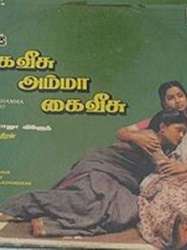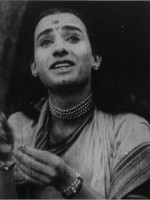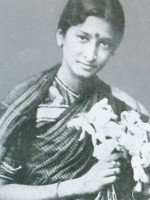Dhundiraj Govind Phalke est un Acteur, Réalisateur, Scénariste, Producteur et Cinématographie Indien né le 30 avril 1870 à Nasik (Inde)

Dhundiraj Govind Phalke, également appelé Dadasaheb Phalke, est un réalisateur indien né le 30 avril 1870 à Trimbak et décédé le 16 février 1944 à Nasik. Il est considéré comme le père du cinéma indien.
Un prix, qui porte son nom, est remis chaque année en Inde : le Prix Dadasaheb Phalke.
Dhundiraj Govind Phalke was born on 30 April 1870 in Marathi family at Tryambakeshwar, 30 km. from Nashik, Maharashtra, India, where his father was an accomplished scholar.
He joined Sir J. J. School of Art, Mumbai in 1885. After passing from J.J. School in 1890, Phalke went to the Kala Bhavan in Baroda, where he studied sculpture, engineering, drawing, painting and photography.
Early career
He began his career as a small town photographer in Godhra but had to rat business after the death of his first wife and child in an outbreak of the bubonic plague. He soon met the German magician Carl Hertz, one of the 40 magicians employed by the Lumiere Brothers. Soon after, he had the opportunity to work with the Archeological Survey of India as a draftsman. However, restless with his job and its constraints, he turned to the business of printing. He specialized in lithography and oleograph, and worked for painter Raja Ravi Varma. Phalke later started his own printing press, made his first trip abroad to Germany, to learn about the latest technology and machinery.
Film
Following a dispute with his partners about the running of the press, he gave up printing and turned his attention to moving pictures, after watching a silent film, The Life of Christ and envisioning Indian gods on the screen. Phalke made his first film Raja-Harishchandra effectively marking the beginning of the Indian film industry. Around one year before, Ramchandra Gopal (known as Dadasaheb Torne) had recorded on film a stage drama called Shree Pundalik, in 1912; it was first shown publicly on 3 May 1913 at Mumbai's Coronation Cinema, and shown recording at the same theater. However, the credit for making the first indigenous Indian feature film is attributed to Dadasaheb Phalke as it is said that "Pundalik" had British cinematographers.
Once again, Phalke proved successful in his new art and proceeded to make several silent films, shorts, documentary feature, educational, comic, tapping all the potential of this new medium. Film, having proved its financial viability, soon attracted businessmen who favored money over aesthetics.
Hindustan Films
Phalke formed a film company, Hindustan Films in partnership with five businessmen from Mumbai, in the hope that by having the financial aspect of his profession handled by experts in the field, he would be free to pursue the creative aspect. He set up a model studio and trained technicians, actors but, very soon, he ran into insurmountable problems with his partners. In 1920, Phalke resigned from Hindustan Films, made his first announcement of retirement from cinema, and he wrote Rangbhoomi, an acclaimed play. Lacking his extremely imaginative genius, Hindustan Films ran into deep financial loss, and he was finally persuaded to return. However, Phalke felt constrained by the business and, after directing a few films for the company, he withdrew.
Sound film
The times changed and Phalke fell victim to the emerging technology of sound film. Unable to cope with the talkies, the man who had fathered the Indian film industry became obsolete. His last silent movie Setubandhan was released in 1932 and later released with dubbing. During 1936-38, he produced his last film Gangavataran (1937), before retiring to Nashik, where he died on 16 February 1944, in penury.
Source : Wikidata
Dhundiraj Govind Phalke

Nom de naissance दादासाहेब फाळके
Nationalité Inde
Naissance 30 avril 1870 à Nasik (Inde)
Mort 16 février 1944 (à 73 ans) à Nasik (Inde)
Nationalité Inde
Naissance 30 avril 1870 à Nasik (Inde)
Mort 16 février 1944 (à 73 ans) à Nasik (Inde)
Un prix, qui porte son nom, est remis chaque année en Inde : le Prix Dadasaheb Phalke.
Biographie
Early life and educationDhundiraj Govind Phalke was born on 30 April 1870 in Marathi family at Tryambakeshwar, 30 km. from Nashik, Maharashtra, India, where his father was an accomplished scholar.
He joined Sir J. J. School of Art, Mumbai in 1885. After passing from J.J. School in 1890, Phalke went to the Kala Bhavan in Baroda, where he studied sculpture, engineering, drawing, painting and photography.
Early career
He began his career as a small town photographer in Godhra but had to rat business after the death of his first wife and child in an outbreak of the bubonic plague. He soon met the German magician Carl Hertz, one of the 40 magicians employed by the Lumiere Brothers. Soon after, he had the opportunity to work with the Archeological Survey of India as a draftsman. However, restless with his job and its constraints, he turned to the business of printing. He specialized in lithography and oleograph, and worked for painter Raja Ravi Varma. Phalke later started his own printing press, made his first trip abroad to Germany, to learn about the latest technology and machinery.
Film
Following a dispute with his partners about the running of the press, he gave up printing and turned his attention to moving pictures, after watching a silent film, The Life of Christ and envisioning Indian gods on the screen. Phalke made his first film Raja-Harishchandra effectively marking the beginning of the Indian film industry. Around one year before, Ramchandra Gopal (known as Dadasaheb Torne) had recorded on film a stage drama called Shree Pundalik, in 1912; it was first shown publicly on 3 May 1913 at Mumbai's Coronation Cinema, and shown recording at the same theater. However, the credit for making the first indigenous Indian feature film is attributed to Dadasaheb Phalke as it is said that "Pundalik" had British cinematographers.
Once again, Phalke proved successful in his new art and proceeded to make several silent films, shorts, documentary feature, educational, comic, tapping all the potential of this new medium. Film, having proved its financial viability, soon attracted businessmen who favored money over aesthetics.
Hindustan Films
Phalke formed a film company, Hindustan Films in partnership with five businessmen from Mumbai, in the hope that by having the financial aspect of his profession handled by experts in the field, he would be free to pursue the creative aspect. He set up a model studio and trained technicians, actors but, very soon, he ran into insurmountable problems with his partners. In 1920, Phalke resigned from Hindustan Films, made his first announcement of retirement from cinema, and he wrote Rangbhoomi, an acclaimed play. Lacking his extremely imaginative genius, Hindustan Films ran into deep financial loss, and he was finally persuaded to return. However, Phalke felt constrained by the business and, after directing a few films for the company, he withdrew.
Sound film
The times changed and Phalke fell victim to the emerging technology of sound film. Unable to cope with the talkies, the man who had fathered the Indian film industry became obsolete. His last silent movie Setubandhan was released in 1932 and later released with dubbing. During 1936-38, he produced his last film Gangavataran (1937), before retiring to Nashik, where he died on 16 February 1944, in penury.
Le plus souvent avec
Filmographie de Dhundiraj Govind Phalke (7 films)
Acteur

Satyavadi Raja Harishchandra (1917)
, 16minutesRéalisé par Dhundiraj Govind Phalke
Genres Drame
Thèmes Mythologie, Religion
Acteurs D. D. Dabke or Dattatraya Damodar Dabke, Anna Salunke, Dhundiraj Govind Phalke
Note52%





L'hommage au roi Harishchandra, qui a failli sacrifier son royaume pour son amour de la vérité, s'ouvre sur un tableau montrant le roi, son épouse Taramati et son jeune fils, à qui il enseigne le tir à l'arc. Ils partent à la chasse et le roi s'aventure dans une zone contrôlée par le sage Vishwamitra et son disciple Nakshatra. Pour expier son erreur, le roi est banni. Trois furies apparaissent prises dans les flammes qu'Harishchandra tente de sauver. Ils le séduisent et le poussent à renoncer à son royaume. Le roi endure de nombreuses épreuves avant qu'un dieu n'apparaisse à l'horizon pour rassurer tout le monde sur le fait qu'il s'agit simplement d'un test de l'intégrité du roi.
Réalisateur

Gangavataran (1937)
Réalisé par Dhundiraj Govind Phalke
Thèmes Mythologie, Religion
Acteurs Leela Mishra
Note64%





Gangavataran is based on the tales of the Puranas, a genre of important Hindu, Jain and Buddhist religious texts. The film used special effects to show mythological miracles and fantasy scenes, credited to Babaraya Phalke, son of Dadasaheb. Gangavataran depicted the Hindu deity Shiva, and the divine sage from the Vaisnava tradition, Narada, played by Chitnis and Suresh Pardesi respectively.

Lanka Dahan (1917)
Réalisé par Dhundiraj Govind Phalke
Genres Drame, Fantasy
Thèmes Mythologie, Religion
Acteurs Anna Salunke
Note64%





Rama, the prince of Ayodhya, is exiled to the forests for a term of fourteen years. He is joined by his wife Sita and brother Laxman. Ravana, the demon king, who also wanted to wed Sita, decides to take revenge and abducts her from the forest. While on the search for his wife, Rama meets Hanuman. Hanuman is a great devotee of Rama and promises to find Sita.

Satyavadi Raja Harishchandra (1917)
, 16minutesRéalisé par Dhundiraj Govind Phalke
Genres Drame
Thèmes Mythologie, Religion
Acteurs D. D. Dabke or Dattatraya Damodar Dabke, Anna Salunke, Dhundiraj Govind Phalke
Note52%





L'hommage au roi Harishchandra, qui a failli sacrifier son royaume pour son amour de la vérité, s'ouvre sur un tableau montrant le roi, son épouse Taramati et son jeune fils, à qui il enseigne le tir à l'arc. Ils partent à la chasse et le roi s'aventure dans une zone contrôlée par le sage Vishwamitra et son disciple Nakshatra. Pour expier son erreur, le roi est banni. Trois furies apparaissent prises dans les flammes qu'Harishchandra tente de sauver. Ils le séduisent et le poussent à renoncer à son royaume. Le roi endure de nombreuses épreuves avant qu'un dieu n'apparaisse à l'horizon pour rassurer tout le monde sur le fait qu'il s'agit simplement d'un test de l'intégrité du roi.

Satyavan Savitri (1914)
Réalisé par Dhundiraj Govind Phalke
Genres Drame, Fantasy
Thèmes Mythologie, Religion

Mohini Bhasmasur (1913)
Réalisé par Dhundiraj Govind Phalke
Genres Drame
Thèmes Mythologie, Religion
Acteurs Kamalabai Gokhle
The plot of the film revolves round the theme of the Hindu mythological story of Mohini and Bhasmasur(a) ("ash-demon"), an asura (demon). The god Shiva grants Bhasmasura the power to turn anyone into ashes by touching their head. The demon decides to try the power on Shiva himself. Shiva runs terrified. The god Vishnu, witnessing the unfortunate turn of events, transforms into the seductress Mohini and enchants Bhasmasura. Bhasmasura asks her to marry him. Mohini agrees, but only on the condition that Bhasmasura follows her move for move in a dance. In the course of the dance, she places her hand on her head. Bhasmasura mimics the action, and in turn, reduces himself to ashes.

Raja Harishchandra (1913)
, 40minutesRéalisé par Dhundiraj Govind Phalke
Origine Inde
Genres Drame, Historique
Thèmes Mythologie, Religion, Sexualité, Homosexualité, Transsexuels et transgenres, Mythologie hindoue, LGBT, LGBT, Travestissement au cinéma
Acteurs D. D. Dabke or Dattatraya Damodar Dabke, Anna Salunke
Note58%





Film mythologique inspiré du Mahabharata relatant la vie du roi Harishchandra. Ce roi noble et juste sacrifie d’abord son royaume, puis sa femme et ses enfants, pour honorer sa promesse au Sage Vishwamitra. À la fin, les dieux, satisfaits par sa haute valeur morale, lui rendent sa gloire passée.

Raja Harishchandra (1913)
Réalisé par Dhundiraj Govind Phalke
Genres Drame, Historique
Acteurs Raadhika Sarathkumar, Nirosha Ramki, Anna Salunke
Note56%





Scénariste

Gangavataran (1937)
Réalisé par Dhundiraj Govind Phalke
Thèmes Mythologie, Religion
Acteurs Leela Mishra
Note64%





Gangavataran is based on the tales of the Puranas, a genre of important Hindu, Jain and Buddhist religious texts. The film used special effects to show mythological miracles and fantasy scenes, credited to Babaraya Phalke, son of Dadasaheb. Gangavataran depicted the Hindu deity Shiva, and the divine sage from the Vaisnava tradition, Narada, played by Chitnis and Suresh Pardesi respectively.

Lanka Dahan (1917)
Réalisé par Dhundiraj Govind Phalke
Genres Drame, Fantasy
Thèmes Mythologie, Religion
Acteurs Anna Salunke
Rôle Ecrivain
Note64%





Rama, the prince of Ayodhya, is exiled to the forests for a term of fourteen years. He is joined by his wife Sita and brother Laxman. Ravana, the demon king, who also wanted to wed Sita, decides to take revenge and abducts her from the forest. While on the search for his wife, Rama meets Hanuman. Hanuman is a great devotee of Rama and promises to find Sita.

Satyavadi Raja Harishchandra (1917)
, 16minutesRéalisé par Dhundiraj Govind Phalke
Genres Drame
Thèmes Mythologie, Religion
Acteurs D. D. Dabke or Dattatraya Damodar Dabke, Anna Salunke, Dhundiraj Govind Phalke
Rôle Ecrivain
Note52%





L'hommage au roi Harishchandra, qui a failli sacrifier son royaume pour son amour de la vérité, s'ouvre sur un tableau montrant le roi, son épouse Taramati et son jeune fils, à qui il enseigne le tir à l'arc. Ils partent à la chasse et le roi s'aventure dans une zone contrôlée par le sage Vishwamitra et son disciple Nakshatra. Pour expier son erreur, le roi est banni. Trois furies apparaissent prises dans les flammes qu'Harishchandra tente de sauver. Ils le séduisent et le poussent à renoncer à son royaume. Le roi endure de nombreuses épreuves avant qu'un dieu n'apparaisse à l'horizon pour rassurer tout le monde sur le fait qu'il s'agit simplement d'un test de l'intégrité du roi.

Satyavan Savitri (1914)
Réalisé par Dhundiraj Govind Phalke
Genres Drame, Fantasy
Thèmes Mythologie, Religion
Rôle Ecrivain

Mohini Bhasmasur (1913)
Réalisé par Dhundiraj Govind Phalke
Genres Drame
Thèmes Mythologie, Religion
Acteurs Kamalabai Gokhle
Rôle Ecrivain
The plot of the film revolves round the theme of the Hindu mythological story of Mohini and Bhasmasur(a) ("ash-demon"), an asura (demon). The god Shiva grants Bhasmasura the power to turn anyone into ashes by touching their head. The demon decides to try the power on Shiva himself. Shiva runs terrified. The god Vishnu, witnessing the unfortunate turn of events, transforms into the seductress Mohini and enchants Bhasmasura. Bhasmasura asks her to marry him. Mohini agrees, but only on the condition that Bhasmasura follows her move for move in a dance. In the course of the dance, she places her hand on her head. Bhasmasura mimics the action, and in turn, reduces himself to ashes.

Raja Harishchandra (1913)
Réalisé par Dhundiraj Govind Phalke
Genres Drame, Historique
Acteurs Raadhika Sarathkumar, Nirosha Ramki, Anna Salunke
Rôle Ecrivain
Note56%






Raja Harishchandra (1913)
, 40minutesRéalisé par Dhundiraj Govind Phalke
Origine Inde
Genres Drame, Historique
Thèmes Mythologie, Religion, Sexualité, Homosexualité, Transsexuels et transgenres, Mythologie hindoue, LGBT, LGBT, Travestissement au cinéma
Acteurs D. D. Dabke or Dattatraya Damodar Dabke, Anna Salunke
Rôle Ecrivain
Note58%





Film mythologique inspiré du Mahabharata relatant la vie du roi Harishchandra. Ce roi noble et juste sacrifie d’abord son royaume, puis sa femme et ses enfants, pour honorer sa promesse au Sage Vishwamitra. À la fin, les dieux, satisfaits par sa haute valeur morale, lui rendent sa gloire passée.
 Connexion
Connexion



